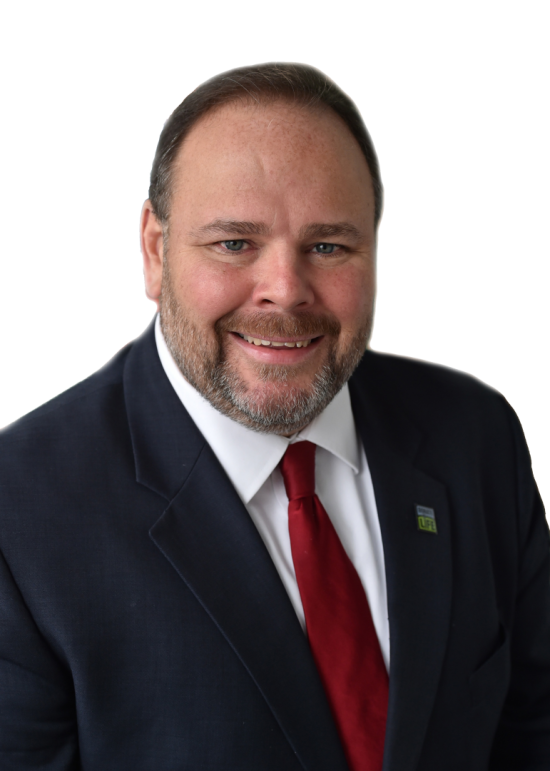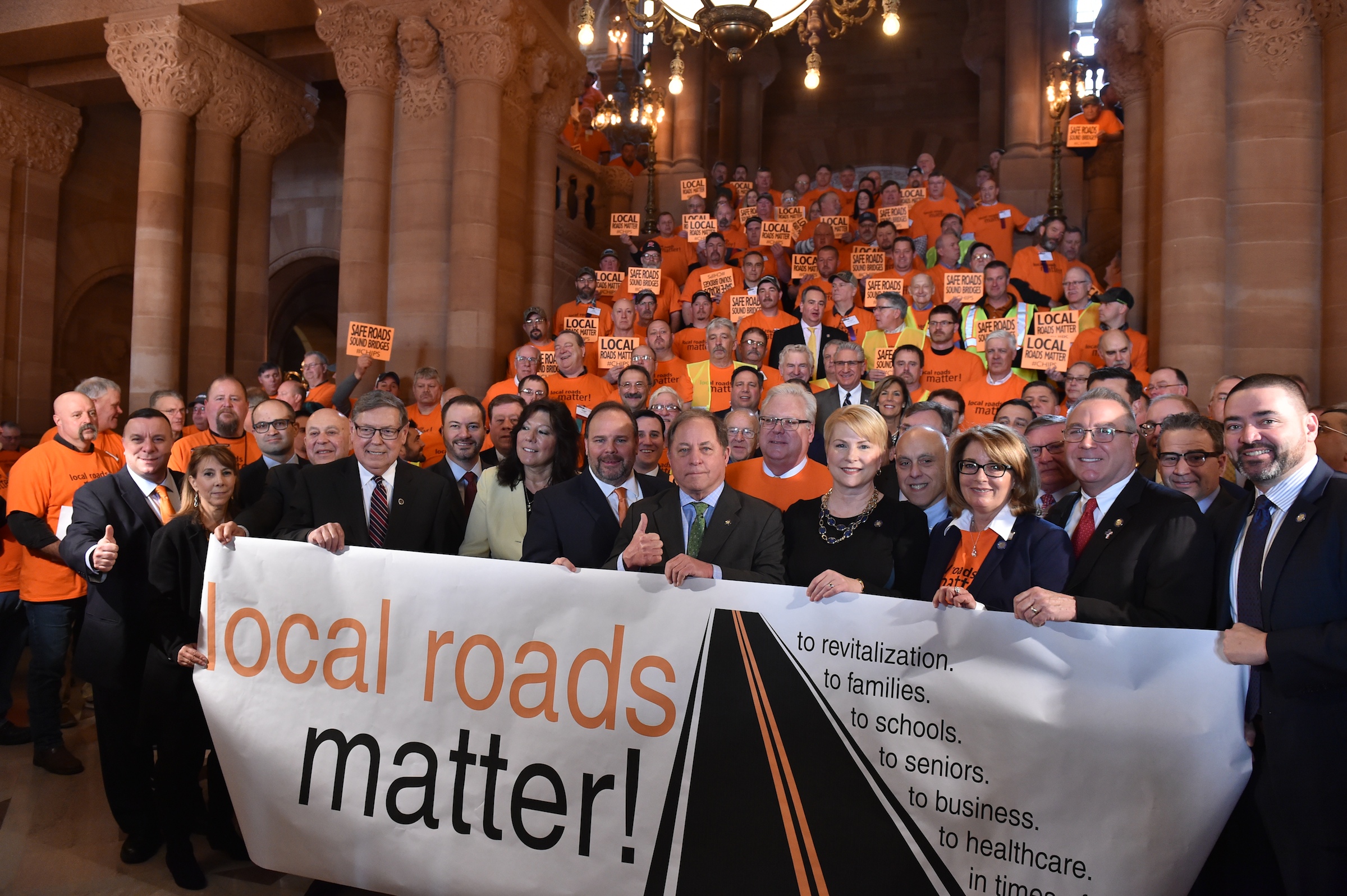State Legislators and Local Leaders: Local Roads and Bridges Need Greater State Investment
‘Local Roads Matter’ coalition again calls on Governor, Legislature to increase CHIPS base aid and restore ‘Extreme Winter Recovery’ funds
Albany, N.Y., March 4—State Senator Tom O’Mara (R,C,I-Big Flats), Assemblyman Phil Palmesano (R,C,I-Corning) and a group of state Senators and members of the Assembly today joined a statewide coalition of county and town highway superintendents and other local leaders to call for increased state support for local roads, bridges, and culverts.
Hundreds of local highway superintendents and highway department employees representing nearly every region of New York State have been in Albany this week for their annual “Local Roads Matter” advocacy campaign. As part of this effort since 2013, O’Mara, Palmesano, and many of their legislative colleagues have joined the local roads representatives to promote a stronger state commitment to local transportation infrastructure. The group notes that overall since then, largely through a series of “extreme winter recovery” allocations distributed through the state’s Consolidated Local Street and Highway Improvement Program (CHIPS) funding formula, and together with the PAVE-NY and BRIDGE-NY programs established in 2016, important increased state support has been provided for New York’s counties, cities, towns, and villages.
Nevertheless, with Cuomo touting in his recent 2020-2021 proposed Executive budget that “New York State is forging ahead with the nation’s most aggressive $275 billion infrastructure program,” the Local Roads Matter coalition is again calling on the state to strengthen its commitment to local transportation by increasing CHIPS base aid for the first time in seven years.
Among other studies, they point to an October 2017 report from State Comptroller Thomas DiNapoli estimating that locally owned bridges alone need at least $27.4 billion in repairs. An earlier report from the comptroller called 32% of New York’s local bridges deficient and 40% of local roads fair or poor, and getting worse. Last September, a new report by TRIP, a Washington, D.C.-based national transportation research nonprofit, found that 10 percent of bridges across the state are in poor/structurally deficient condition – the 12th highest rate in America.
According to TRIP, nearly 12 million vehicles cross a poor/structurally deficient bridge in New York State every day.
In a March 2 letter to Cuomo and legislative leaders, O’Mara, Palmesano and their Senate and Assembly colleagues wrote, “We believe that New York State’s investment in local transportation infrastructure must be a foundation of the nation’s most aggressive infrastructure program in order for this program to achieve its envisioned goals…We once again stress that New York State’s direct investment in local roads and bridges through the Consolidated Local Street and Highway Improvement Program (CHIPS) remains fundamental to the mission highlighted above. It deserves priority consideration in the final allocation of the record level of state investment the Executive proposes for the 2020-21 fiscal year. CHIPS is the key difference for local communities, economies, governments, motorists and taxpayers throughout the Empire State, including New York City and surrounding metro areas, and we should no longer ignore this fact. This session, perhaps more than ever before, we believe the opportunity exists to strengthen past successes and, most importantly, revitalize our investment to address the tremendous, still unmet needs and challenges facing the effective maintenance and improvement of local roads, bridges and culverts in every region of New York State.”
This year the group is calling for increasing state base aid for CHIPS by $150 million to a total of $588 million, noting that the CHIPS base level has remain unchanged at $438 million since 2013. The group also seeks the restoration of a $65-million “Extreme Winter Recovery” allocation that Cuomo eliminates as part of his 2020-21 proposed state budget and calls on the governor and legislative leaders to:
- Achieve the past practice of mutual five-year Capital Plans between the Metropolitan Transportation Authority (MTA) and Department of Transportation (DOT) with parity as a priority that benefits both upstate and downstate;
- Achieve upstate-downstate parity in the percentage funding increases proposed for the five-year MTA Capital Plan and a two-year DOT Capital Plan;
- Doubling PAVE-NY local funding from $100 million to $200 million annually; and
- Doubling BRIDGE-NY local funding from $100 million to $200 million annually, with additional funding for culverts.
In a 2013 study, the state Association of Town Superintendents of Highways (NYSAOTSOH) estimated that New York would need to invest an additional $1.3 billion per year on local roads and bridges to prevent them from becoming deficient.
Todd Gadd, President of the New York State County Highway Superintendents Association (NYSCHSA), said, “The Executive Budget, while continuing important local transportation funding programs, does not provide the necessary increases for these programs in the proposed abbreviated two-year transportation capital plan. NYSCHSA, along with our affiliates, is urging our Legislative representatives to make local roads and bridges a priority in this year’s budget, beginning by restoring EWR and increasing CHIPS funding. We all agree that a significant increase in the CHIPS base aid and the restoration of EWR funds is an effective way to help all municipalities improve the conditions of our statewide system of roads, bridges and culverts, promote job creation and economic development in our communities, and improve highway safety and functionality on behalf of the motoring public.”
Joel Kie, President of the New York State Association of Town Superintendents of Highways (NYSAOTSOH) and Town of Dickinson (Broome County) Highway Superintendent, said, “Eighty-seven percent of New York State’s roads and over half of its bridges are owned and maintained by local governments. The New York State Association of Town Superintendents of Highways supports a $150-million increase in CHIPS and the restoration of $65 million in Extreme Winter Recovery Funding to support local roads, bridges and culverts. This requested additional infrastructure funding is necessary to provide the public with a safe and functional statewide transportation system, one that supports jobs and economic growth for our communities.”
Stephen J. Acquario, Executive Director of the New York State Association of Counties (NYSAC), said, “NYSAC stands with our county highway superintendents who work hard each and every day to plow and pave our roads and bridges. As melting snow gives way to major road disrepair it is more important than ever that we support our State Lawmakers who invest in the CHIPS program and provide funding for Extreme Winter Recovery.”
Gerry Geist, Executive Director of the Association of Towns of the State of New York (AOT), said, “Our state economy depends on our roads in order to thrive. Our local highway departments are out there with the postal workers, in the sun, sleet, humidity, snow and ice, ensuring New Yorkers can get where they’re going quickly and safely. Of the $1.4 billion towns spend annually on their road care and repair, just $130 million comes from CHIPS. Investing in our roads today will ensure that New Yorkers are not just using them on their way out of the state, but to our schools, businesses and landmarks.”
Christopher Koetzle, Town of Glenville (Schenectady County) Supervisor and AOT Executive Committee Member, said, “As Glenville town supervisor, I can tell you that we depend on the funding we receive from CHIPS and the other bridge and culvert funding programs to keep our local roads in tip-top shape as we try to grow our economy and keep our rates down. Investing in our roads is an investment in all New Yorkers, and I urge the state to continue funding CHIPS, PAVE-NY, BRIDGE-NY and Extreme Winter Recover at the highest levels possible.”
Peter A. Baynes, Executive Director of the New York State Conference of Mayors and Municipal Officials (NYCOM), said, "Local roads and bridges are the bedrock of New York's transportation network and they support all sectors of New York's economy. A strong and growing state investment in our municipal roads and bridges is both essential and smart. NYCOM strongly supports this bipartisan effort to increase CHIPS funding and restore the Extreme Winter Recovery program."
Renee St. Jacques, New York Farm Bureau Assistant Director of Public Policy, said, “Local roads matter to farmers. The state's family farms depend on safe roads and bridges to access farm fields, transport milk to processors and to get goods to market in a timely manner for consumers. Infrastructure remains a priority for New York Farm Bureau, and we encourage continued investment to support food access and our rural economy."
Michael J. Elmendorf, President and CEO of the Associated General Contractors of New York State (AGC NYS), said, “Governor Cuomo has shown a substantial commitment to infrastructure funding in the 2020-21 Executive budget, and we commend the Governor for recognizing the struggles New Yorkers face in their day-to-day travels to work, school and local businesses. The CHIPs program provides a critical funding source for our local roads, and to deny communities the investment they need would be a disservice. Local governments are facing increased budget cuts, and providing safe roads for emergency services, work, school and beyond is an important safety and economic investment in the future of New York.”
Dave Collins, Chairman of Rebuild NY Now, said, “At the local level, cash-strapped communities deserve the support of New York in repairing the roads that take our citizens where they need to go every day. Each and every New Yorker is a stakeholder in our State’s roads, and it is time for Albany to step up to meet local infrastructure needs. Thank you to Senator O’Mara and Assemblyman Palmesano for continually leading the charge in demanding action for local roads.”

